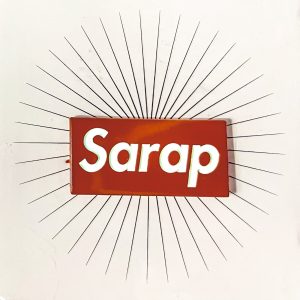Fun With Phonics
If I haven’t said this enough … I cannot speak or understand Tagalog. Though there are obvious words that every Fil-Am kid knows; malamig (cold), masarap (delicious), mabaho (stinky), tubig (water), kumustaka (how are you?), bakit (why?). Some phrases just get picked-up in conversation; like nagtatrabaho ka ba (are you working tonight?) or pupunta tayo sa misa (we’re going to mass).
I may not understand it word for word, but I do get the context of what they are talking about, especially when they speak in Tag-lish. 1 That said, I love being around and listening to my family and friends when they speak Tagalog. It’s a comfort to me. It reminds me that I’m surrounded by loved ones, even if I don’t fully understand what they are saying.
It’s funny. Even though I don’t speak the language, apparently, I’ve picked up some habits from listening to Tagalog and Taglish my entire life. Truth be told, I hadn’t even noticed it until a couple years into working full time after getting my RN license. And I didn’t even know WHY. In fact, when growing up it was something that many of us kids used to make fun of our parents, and Titas & Titos. 2
It was the use of pronouns. You know (say it with pride, SVF 3rd Grade Sr Barbara students!), Me – You – He – She – It – They – Them. Emphasis on the SHE and the IT … and said rapidly, as one word. 3
Difficulty with pronouns occur with most of my family & family friends that grew up speaking Tagalog as their primary language. They often get their He/She or Him/Her confused. Many times they resort to saying They/Them, or just referring to a person simply as one run-on word “He-She.” In return, I find myself doing the same thing. Getting my pronouns mixed up. Which seems awfully strange, but I’ve been it’s not unusual that this happens if you are brought up in a two-language household. It had been no big deal for the most part … until it wasn’t.
When I first started working full time, my co-workers found my mix-up of pronouns endearing. After the gazillionth time it became annoying. It became embarrassing to me whenever it happened, especially while talking with a patient or physician. “He-She” became a staple word in my vocabulary. It was that or, “He – <pause & blink> I mean, She” (or vice versa) every time I used a pronoun. There were times where patients or family members would look at me as if I couldn’t tell the difference between a cat and a dog. And believe me, there were many times I was told to “get glasses” or asked if I was blind and “can’t you see I’m obviously a <insert gender>.”
Getting to Sesame Street
The last time I was in the Philippines was in 2014. Before that was when I was 9 years old. I have lots of fond memories from that trip in the ‘80’s and to this day, my cousins tease me about the time I lost my balance and fell into the sewer. “Mabaho ka na!” (You stink!)
Going back as an adult, I was more aware of my surroundings and tried my best to be present with any interaction I had with everyone. To be honest, I did that for three reasons. Number 1): I didn’t want to get lost, since I didn’t know my way around. Number 2): I didn’t speak or understand fluent Taglish. And Number 3): I didn’t want to get kidnapped. I’m only half-kidding about that last one, but that’s what every Fil-Am kid who doesn’t speak Tagalog is told when they go to Manila.
Believe me, any Filipino in the Philippines can spot a Fil-Am kid right on the spot. We may physically look the same, but we stand out in the crowd by our clothes, the volume of our voice, even the tone of our skin (the darker you are, the more American you are). So yes, when I’m approached at a store at one of the gazillion super malls in Manila or am seated at a restaurant and are asked what I’d like to order … they know to speak English to me. 4 And this is what I’m always greeted with:
“Good morning (or afternoon), Ma’am, Sir”



Have you ever called a Customer Service line for any major business and *actually* got to speak with a live person on the phone? Did the person happen to address you as “Ma’am, Sir” at any point during the conversation? Chances are you have a Customer Service Rep answering your call from the Philippines. So please be patient with them. 5
Let me tell you the reason why Filipinos get their pronouns mixed up. It’s not that we don’t know the difference. (Like I mentioned above, I’ve gotten that line more times than you think.) Or that we’re fumbling to determine your gender identity. It’s because Tagalog is a Gender-Neutral language.
A Gender-Neutral language is one that avoids references towards a particular sex or gender. For example, gender-neutral words in English would be “Postal Worker” or “Flight Attendant,” whereas gender-specific counterparts are “Mailman” or “Stewardess.” In Tagalog, when referencing a person, the word “siya” is used for both “he” and “she” as well as “it.”
That’s not to say that Tagalog doesn’t have any gender specific words, especially after over 3 centuries of Spanish influence. Those gender specific pronouns, just like Spanish, can be identified by their suffix: -o (Tito, Lolo, Pinoy) for masculine; -a (Tita, Lola, Pinay) for feminine. There are other gender differentiating pairs such as Ate (pronounced ah-teh) and Kuya for eldest sister/brother that are influences from China. But for the most part, when referring to a person there *is* no male or female counterpart.
Gender Fender Bender
Today, using the correct pronouns is important more than ever. Addressing a person in the way they wish to be addressed is paramount and should have NOTHING to do with gender identity in the first place.
I think back to BEFORE using the correct pronouns were, well – more pronounced. And how I would constantly get the “evil eye” from family members or be told by other health care professionals that I “needed to get my pronouns straight.” I remember how offended people would get when I goofed up simply because the language my culture speaks doesn’t have a specific pronoun for gender. And how I constantly make an effort to pause before using pronouns because of this.
And then I wonder HOW HARD it is for people to make the effort to do the same today.
- Half Tagalog, Half English ↩︎
- Aunts & Uncles ↩︎
- Lame, I know, but us Catholic school kids had to find a way to swear back then! ↩︎
- Most Filipinos are bilingual as, during the 50 years of US occupation of the Philippine Islands, many elementary schools taught in English and required students to only speak English during class ↩︎
- Not only because it’s not their fault that you’ve been on hold for so long, but it’s just outright rude. ↩︎
